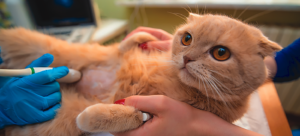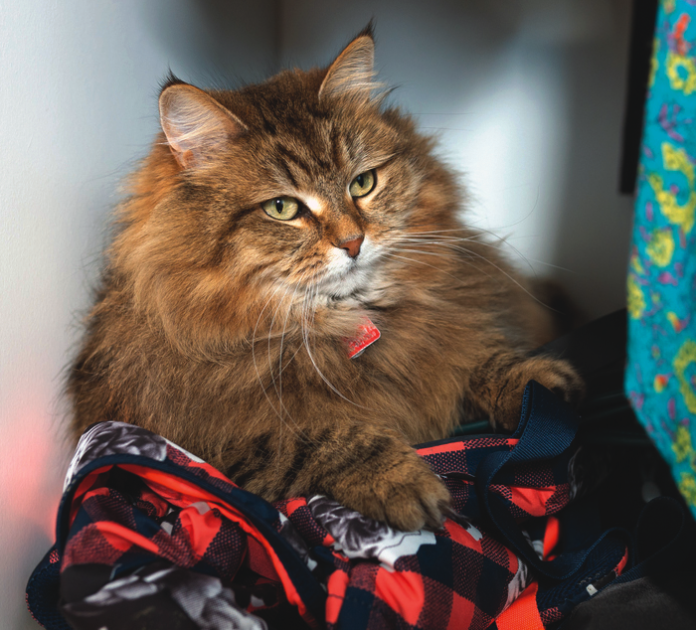Inflammatory bowel disease (IBD) is caused by an abnormal influx of inflammatory cells into the gastrointestinal (GI) tract. These cells thicken the walls of the GI tract and interfere with digestion and the absorption of nutrients. Cats of any age can get IBD, but it’s usually middle-aged and older cats. Male and female cats are equally affected. Based upon similarities between IBD in people and dogs, genetic abnormalities of the immune system are thought to play a role in feline IBD.
While the cause of IBD is poorly understood, it is believed to arise from a complex abnormal interaction of the immune system, diet, bacterial populations in the intestines, and other environmental factors. In spite of the fact that it can be a challenge to diagnose, affected cats can live high-quality, comfortable lives.
Signs of IBD
Most cat owners first notice vomiting, which initially may be dismissed as a hairball problem, but chronic vomiting may indicate IBD in the stomach or small intestine. Affected cats may have diarrhea, and blood in the diarrhea may indicate large intestine involvement. Many cats will lose weight despite a voracious appetite. Other cats may show a decreased appetite and weight loss.
Abdominal pain and lethargy may be observed, and chronic or severe cases may develop hypoproteinemia (low levels of protein in the blood) with associated fluid buildup in the abdomen, which is called ascites (see “Ascites Is a Serious Symptom,” CatWatch July 2020, available at catwatchnewsletter.com). Ascites requires immediate veterinary attention.

marieclaudelemay | iStock photo
Detective Work
Diagnosing IBD usually begins with ruling out intestinal parasites and screening for feline leukemia virus (FeLV), feline immunodeficiency virus (FIV), and hyperthyroidism, all of which can show similar clinical signs. Additional diagnostic blood tests may be performed, including:
- Serum biochemistry
- Complete blood count
- Serum folate
- Vitamin B12
On physical examination, your veterinarian may palpate thickened loops of intestines due to the infiltration of inflammatory cells.
Radiographs are not usually helpful, but an abdominal ultrasound may suggest IBD and can help evaluate the liver and pancreas as well. (Cats can have inflammatory disease in the small intestine, liver, and pancreas at the same time, a condition called “feline triaditis.”)
To arrive at a definitive diagnosis, biopsies of the intestine obtained via either an endoscope (flexible camera that is passed into the GI tract) or laparotomy (surgical opening of the abdomen) are often necessary. Both modalities require general anesthesia. Even with biopsies, the distinction between IBD and small-cell lymphoma can be challenging in some cases.
Many veterinarians choose to start treatment based on a presumptive diagnosis of IBD before recommending intestinal biopsies. If your cat is elderly or frail, this may be the best option. Treatment for internal parasites is often recommended as the first step, as this is not likely to cause harm and may be beneficial if parasites are the cause of the symptoms observed.
Dietary Management
Dietary modification may help get your cat’s IBD under control. Most diet-management recommendations begin with using “novel” protein sources, meaning those your cat has never eaten before, because proteins are often the ingredient that induces an immune response that can lead to inflammation in the GI tract. Rabbit, duck, or venison-based diets are common initial choices. It may take several weeks, or even longer, for cats to improve after a diet change. If novel protein sources are not successful, your veterinarian may recommend a hydrolyzed diet, in which the proteins have been broken down into smaller pieces that may not induce an immune response in the GI tract.
During any food trial, all other food sources—including table scraps, flavored medications, and treats—must be eliminated. If symptoms do not improve with the dietary changes, your cat may benefit from diets that are high in fiber, low in fat, and easily digestible.
Your veterinarian may recommend vitamin B supplementation because IBD decreases the absorption of B vitamins. B12 (cobalamin) is given via injection weekly initially, then it is tapered to every other week and potentially every month or six weeks. Your veterinarian may suggest that you add a prebiotic and/or probiotic to your cat’s diet to help build up the good bacterial flora in the gastrointestinal tract.
Soluble fiber, in the form of psyllium, may help cats with the colitis form of IBD. Omega 3 fatty acids have helped people with Crohn’s disease, and it is theorized that they may help cats, although more studies need to be done.
Additional beneficial nutritional supplements may include vitamin E, vitamin A, vitamin C, zinc, and N acetyl glucosamine. These antioxidants can help suppress inflammation. Note: Trying to just up your cat’s dose of these vitamins without veterinary supervision is not a good idea. For instance, too much vitamin A can cause irreparable damage to the liver.
Medical Therapy
Fecal microbiota transplants are sometimes used as part of treatment for cats with IBD. For this therapy, fecal material from healthy cats is compacted into pills that are then given to the cat with IBD. The goal is to help re-establish normal gut flora in the intestinal tract.
The medication metronidazole has antibacterial, antiprotozoal, and anti-inflammatory effects, so it covers a lot of bases. It may even resolve a mild case of IBD, although flare-ups are common. Some cats will lose their appetite while on metronidazole. It is not usually prescribed long-term.
Most veterinarians also prescribe a corticosteroid, such as prednisolone, to decrease inflammation in the GI tracts of cats with IBD. All steroids have some side effects, though, including suppression of the immune system, increased appetite, thirst, and urination, and the potential development of diabetes mellitus. Luckily, cats are moderately resistant to many side effects of these medications.
While cats may need to start on a high dose of corticosteroids to get IBD under control, the goal is to gradually reduce the dose to the minimum needed to be effective. In many cats, dosing frequency can ultimately be decreased to every other day.
Budesonide is a corticosteroid drug that is used to treat conditions like Crohn’s disease and ulcerative colitis in people. Now also being used to treat IBD in some cats, its actions are localized to the intestinal tract, which means less chance of systemic side effects. Unfortunately, it is quite expensive.
Severe cases of IBD often need stronger immunosuppressive medications, such as chlorambucil. While these medications can help control IBD symptoms, they also have some serious potential side effects, including a decrease in the production of white blood cells, red blood cells, and platelets in your cat’s bone marrow.
Under Study
Stem-cell therapy is showing some promise in the treatment of feline IBD. In this modality, mesenchymal stem cells are isolated from adipose (fat) sample taken from the cat to be treated. By using the cat’s own cells, the likelihood of rejection is minimized. The processed cells are given by intravenous injection. It is not clear whether the mesenchymal stem cells act as immunosuppressants or more as immune-tolerance agents, but they do have immunomodulating effects.
Limited studies on the use of stem-cell therapy for feline IBD have been carried out so far, but based on human studies, this is a promising potential treatment for IBD in cats. In a study performed at Colorado State University, five of seven cats with IBD showed a positive response to stem-cell therapy.
The prognosis for complete resolution in cats with IBD is guarded, but about 80% of affected cats respond to diet and prednisolone therapy and can be managed successfully. Unfortunately, severe IBD may progress to small cell lymphoma in some cats.
The “Itis” Dictionary
You may hear different terms used for IBD depending on what areas of the GI tract are affected:
- Gastritis: stomach
- Enteritis: small intestine
- Colitis: large intestine
Clinical Trial at CSU
The Feline Cancer Core at Colorado State University (CSU) is studying the use of stem cells to treat feline IBD. Cats with a biopsy-confirmed diagnosis of IBD can be entered in the study. If an adult cat has chronic diarrhea, but has not yet had a biopsy, the study may pay for the diagnostic workup needed. The study also will pay for most of the costs associated with treatment. For more information, go to https://tinyurl.com/CSU-study.




